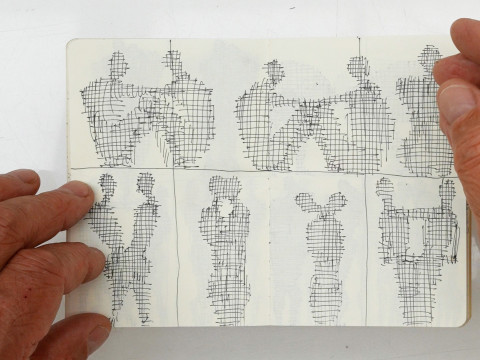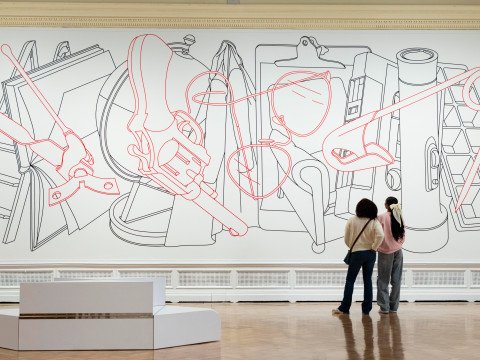
How to read it: Meredith Frampton's Still Life
By RA Collections team
Published on 19 May 2020
This meticulous and mysterious work by Meredith Frampton is full of contrasting symbolism. Our Collections team guide you through it in this three-minute read.
A version of this article was originally published in February 2017.
The sullen expression of a stone bust Meredith Frampton inherited from his father sets the tone for this entire painting: anger and unease. The head, gazing out of the picture plane draws the viewer into the rest of the imagery. Frampton’s nostalgic symbolism was typical of the inter-war years, which simultaneously aspired to, and mourned the loss of, classicism’s sense of order. Frampton’s is not an idealised classicism, however; the bust is chipped, the vase broken, the flowers wilted and the trees are severed.
Who is Meredith Frampton?
London-born Frampton was a painter and etcher, the son of two artists who met at the Royal Academy Schools. His father, Sir George Frampton RA was elected to the Royal Academy in 1902, exactly 40 years before Meredith became an Academician in 1942. Still Life was the work Meredith Frampton donated to the Academy collection on his election (his "Diploma work"). Although Frampton became largely unknown after he gave up painting in the 1950s, a solo exhibition at Tate in 1982 brought him back to public attention.

Do the objects mean anything?
Frampton’s imagery is imbued with conflicting symbolism, embodying the discord between an idealised vision and the disorder of reality. Nature is represented in the trees, flowers and the landscape in the background. The man-made is symbolised by the stone head, masonry and the tape measure. The head denotes intellect and the tape measure human constructs: both in contrast to the wild flowers. Life is seen alongside death in the combination of funerary masonry with severed trees. Even the method of demolition is conflicting: one tree has been smoothly cut and another torn and fractured.
The sense of tension is emphasised by the composition which is dominated by both vertical and horizontal lines and has flashes of bright colour against an otherwise colourless setting: the red notably highlights both the natural flowers and the man-made tape measure. Considering Frampton’s unceasing attention to detail, it seems unlikely to be chance that the tape measure forms an ampersand. He seems to be inviting the viewer to add up and decipher the symbolism in the image: a difficult task considering the abundant contradictions.
I never joined a movement. I’ve always been alone. Always alone.
Meredith Frampton RA
How did he create the smooth effect in paint?
Frampton valued precision, meticulously constructing his compositions (copying from life but piecing the objects together on the canvas), and painstakingly captured every detail. It is a testament to his skill that he would not work from preparatory drawings but worked directly onto the canvas with the paint brush. Each painting would take up to a year to complete and his perfectionism resulted in a relatively short career as an artist. Whereas many artists would adapt their technique to changing conditions or states of health, Frampton gave up painting altogether when his eyesight started to deteriorate in 1953. Tellingly, his sight was still sufficient to go about daily life. It was this time-consuming quest for perfection that guided Frampton’s choice of subject matter: still lifes or portraits. When he attempted landscapes they would change in front of him, through weather conditions or human impact. Still lifes allowed him unchanging subject matter that he could control.
Who influenced him?
Frampton’s ultra-smooth surface makes it look almost like a Surrealist painting, but Frampton would not have welcomed the association; he admired Salvador Dalí but said of the rest of the movement: "I just didn’t care. I knew how easy it was to do that sort of thing." It was not only Surrealism that Frampton disparaged. He also expressed indifference for Henri Matisse and dislike for Pablo Picasso, claiming that he had never seen a reproduction of Picasso’s famous painting Guernica, or a sculpture by his British contemporary Henry Moore. He said "I never joined a movement. I’ve always been alone. Always alone." However, his work has subsequently been linked to the Neo-Realists Charles Ginner and Harold Gilman, and members of the Euston Road School. In an essay of 1914, Ginner argued that "Neo-Realism by its very ideals finds itself opposed to the slap-dash, careless, and slick painting which has been and is still so much in vogue."
Discover Meredith Frampton RA’s Still Life in 60 Seconds, with this quick video primer.
Related articles

My sketchbook: sculpture drawings by Antony Gormley RA
13 January 2025

Video: Merry Christmas from the Burlington House choir
18 December 2024

Video: drawing on gallery walls with tape
15 October 2024